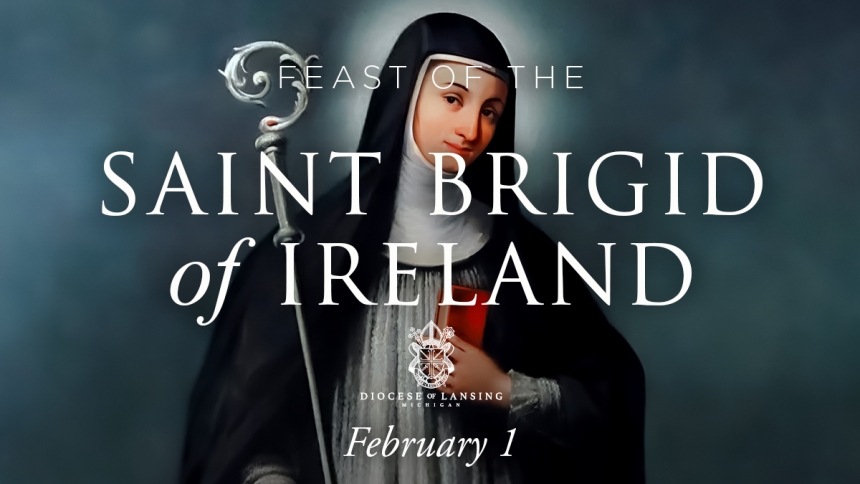
Today is the Feast of Saint Brigid of Ireland. Father James Conlon is the pastor of Saint Francis of Assisi in Ann Arbor and a native of County Sligo in Ireland. Why does he love Saint Brigid? Why should we love Saint Brigid? Father Conlon has this to say:
As is often the case, details of the lives of the early saints can often be scant, leading some to argue that they might not have actually existed, or that they were really pagan deities Christianized by the Church in an attempt to win over the community. So it is with Saint Brigid or as the Irish call her Muire na nGael (Mary of the Irish), reflecting her maternal role and influence in sharing the Gospel with the people of Ireland and beyond.
While there are few documented historical facts about her and, yes, her hagiographies do contain many anecdotes and miracles some of which could very well be hero tales from Celtic mythology, this does not prove that she never existed. For alongside them stands a strong and robust tradition of a woman who was committed to Christ and His Church and was known for her generosity and charity, her simplicity of life, her astuteness and worldly detachment – her holiness!
Born around the year 450 AD, Brigid, like many of the early virgin saints, committed her life to Christ from a young age and desired a hermitical life of prayer. Despite family objections and the never-ceasing demands of others, this solemn commitment would remain the very heartbeat of her life. Very quickly her holiness and way of life caught the attention of other young women who sought to join her in a life of prayer and service. With the assistance of Saint Conleth, together they founded a double monastery, housing both monks and nuns. As the first bishop of Kildare, Conleth readily shared leadership responsibility with Brigid, for he understood and appreciated her gifts and her desire to serve God by serving others. Very soon Kildare would become a center of great learning, famed for its metalwork and illuminated manuscripts, and the motherhouse of many other monasteries that looked to Brigid for leadership and inspiration.
Throughout her life Brigid was famous for the power of her prayer and witness. Stories abound of her acts of charity, physical healings of the sick and disabled, her ability to multiply food for the poor, to control the weather to ensure a good harvest, and the favorite of many- to turn water into beer! And yet her enduring gift to the Church has to be the Saint Brigid Cross – a simple cross made from rushes. It is said that she was once called to the deathbed of a local chieftain who had until that moment refused to accept Christ. Knowing that time was short, Brigid gathered some rushes and skillfully wove them together into a rustic cross. When asked to explain what she was doing – she replied “This is a cross, which I make in honor of the Virgin’s Son, who died for us upon a cross of wood.” She then spoke so convincingly about Christ and His saving death on the cross, that the dying man immediately asked to be baptized and died a Christian.
Not to be confused with the lesser-known Bridget of Sweden, Brigid of Kildare, often depicted with a crozier to reflect her jurisdiction as an abbess, continues to influence not just the Church in Ireland but throughout the world. She belongs to that shining period of early Irish Church history populated with countless men and women committed to the spread of the Gospel – men like Colmcille, Brendan the Navigator, Columbanus and women like Dymphna, Ita and Attracta. These were the giants who laid the foundations for what would later be known as the Land of Saints and Scholars, a land that would give to the world generations of priests, sisters, and brothers who, like Brigid, had one desire – to share Christ and his Gospel with others.
Brigid died in the year 525 AD, (1,500 years ago today, in fact) and according to tradition is now interred with Saints Patrick and Colmcille in the Church of Ireland Cathedral in County Down. Today, in Ireland, as they celebrate her feast day, it is also considered the first day of spring – something that may actually have its roots in the old Celtic calendar with the festival of Imbolc. And yes, by now in some areas of the island, the green shoots of new life have already begun to sprout.
So, what can we learn from this woman of faith? Certainly, her love of Christ and the Church, her preferential option for the poor, her dedicated life of prayer and her deep understanding that God’s love is a powerful force – just take a moment to read this short poem, traditionally attributed to Brigid. It captures both her joie de vivre and her love of real authentic honest prayer!
I’d like to give a lake of beer to God.
I’d love the heavenly
Host to be tippling there
For all eternity.
I’d love the men of Heaven to live with me,
To dance and sing.
If they wanted, I’d put at their disposal
Vats of suffering.
White cups of love I’d give them
With a heart and a half;
Sweet pitchers of mercy I’d offer
To every man.
I’d make Heaven a cheerful spot
Because the happy heart is true.
I’d make the men contented for their own sake.
I’d like Jesus to love me too.
I’d like the people of heaven to gather
From all the parishes around.
I’d give a special welcome to the women,
The three Marys of great renown.
I’d sit with the men, the women and God
There by the lake of beer.
We’d be drinking good health forever
And every drop would be a prayer.
Saint Brigid of Ireland, pray for us!
